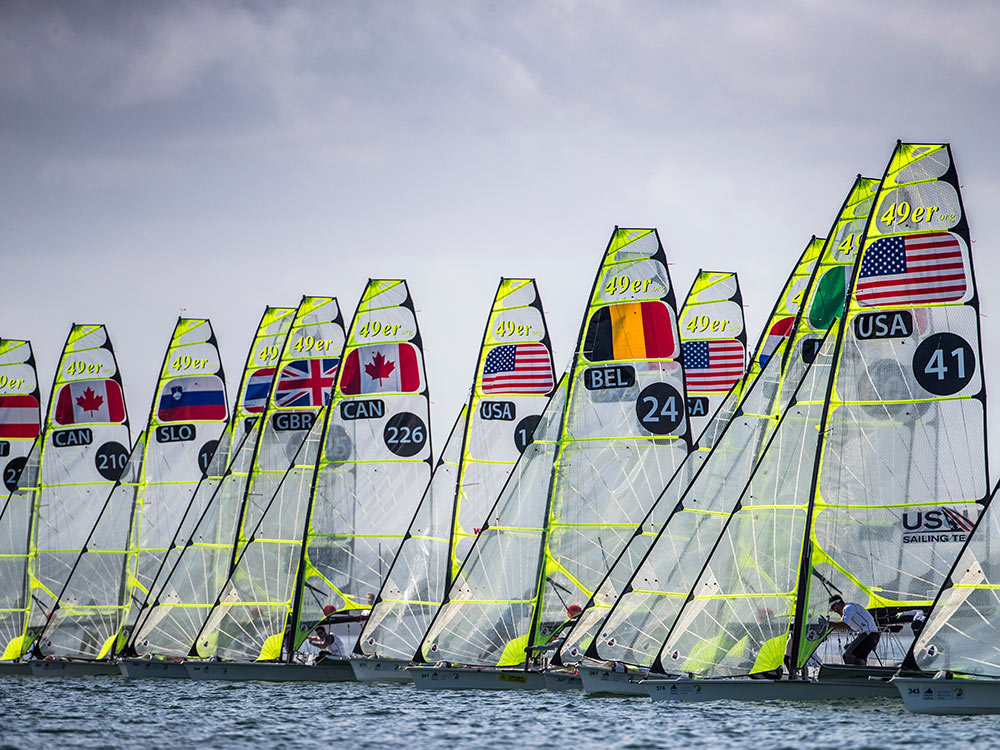
2018 WORLD CUP SERIES MIAMI
Want to be able to hold your position on the line with the best of them? In dinghy sailing and skiff sailing, down-speed boathandling will get you well on your way. That’s because some boats, such as skiffs, often set up as early as 3 minutes from the start and have to hold their position on the line by doing tiny circles right up until the start. To do those, the goal is to always be in one of three modes—going forward, backward, or sideways—and never lose flow over the blades. A lot of people end up sitting on the line with no flow, and as a result have no control over their boats. But if you always have some form of flow, you have control. The goal of this drill is to maintain that flow and get really good at transitioning from one mode to the other. All you need is an inflatable mark, one you can hit without damaging the boat. In a nutshell, here’s the drill: Sail to the mark on the starboard tack layline, passing the mark to starboard. When the transom clears the mark, shoot head to wind, then backwind both sails and use the rudder to crab, or slide, the boat sideways to windward. Once on the other side of the mark, sail backward until the mark is off the port bow, and then repeat the drill. The most challenging part is moving the boat sideways after you first clear the mark. You must learn to balance the foils and the sails so you can put the bow just barely through head to wind, not yet on port tack, and get the boat to move sideways without spinning out to the left or right. Back the main on the port side with the bow slightly through head to wind. Then pull the tiller to windward—to starboard. The sails will push the boat up to the starboard side of the mark and rudder will push the stern up. When you first try this, you’ll likely have to scull to keep the boat under control, which of course is illegal. But the better you get at balancing the sails and foils, the less sculling you’ll need and eventually, if you balance the sails correctly, you won’t need to scull at all. The goal is to slide without having to use any rudder. It’s almost like you’re doing a really quick double tack. Done well, you’ll slide to windward of the mark without ever falling onto port tack.
Any time you’re doing the sliding part of this drill, you’re at risk of fouling a boat that’s sitting on starboard to windward of you. Get yourself as closely tucked in next to the boat to windward as possible without getting so close that they can touch you if they put the bow down. To do that, you have to know how far the boat’s going to slide. Also, you’re essentially tacking, as you’ve gone beyond head to wind, and you don’t get any rights until your bow is returns to a closehauled course.
The final segment is reverse mode, backing down past the mark. Site over the tiller, and the direction the tiller points to is the direction the back of the boat is going to go. For instance, if the tiller points to port, the stern is going to go to port. You now have reverse flow over the blades, meaning you still have steerage and thus control of the boat. Once your bow is to leeward of the mark, transition back to the starboard-tack mode.
If you can hold your position on the line, the more starting will become a tactical battle. If you’re the leeward boat, your goal is to be in sync with the windward boat. When the windward boat goes forward, you go forward. When the windward boat goes sideways to windward, you go sideways to windward. When the windward boat goes backwards, you go backwards. You’re doing that with the expectation that each time they make a small mistake, they fall into you a little bit more. A few mistakes on their part, and all of a sudden you’re in control of the windward boat.
If you’re windward boat, stay out of synch with the boat to leeward of you. When the leeward boat slides to windward, go forward and call starboard. That’s going to stop them from going sideways, and their next move will be to sail backward. When they do that, you should slide to windward. If you can get out of sync with the leeward boat, you control them.









